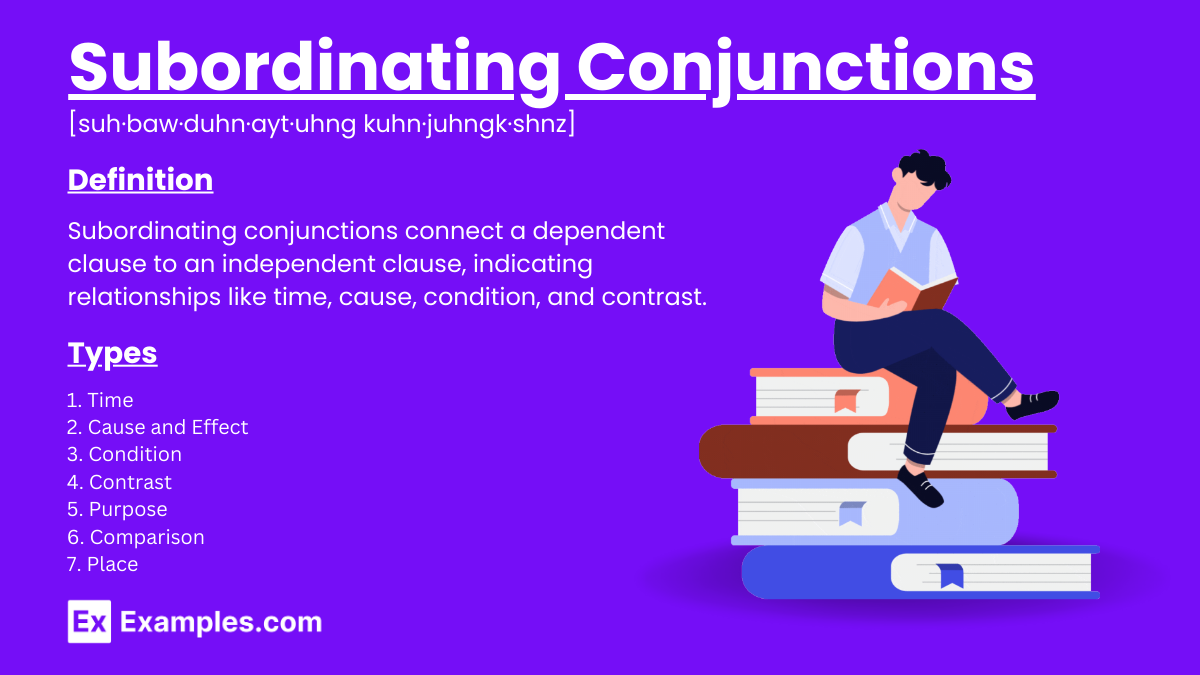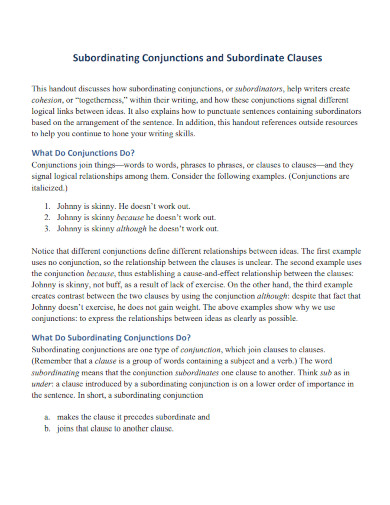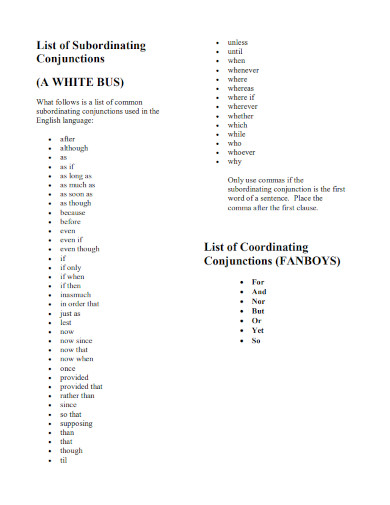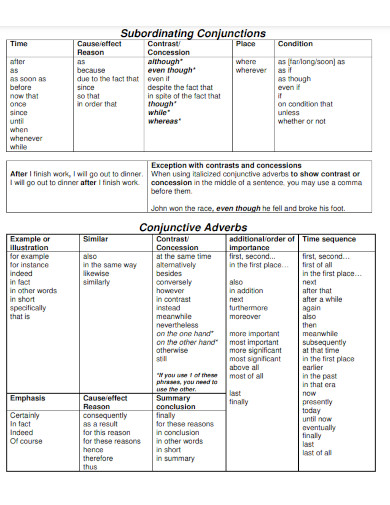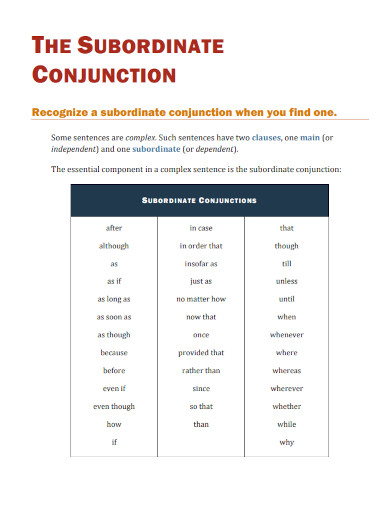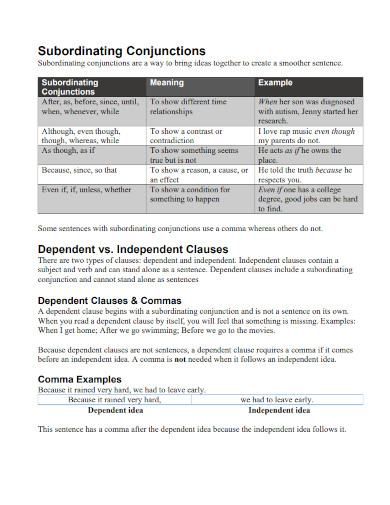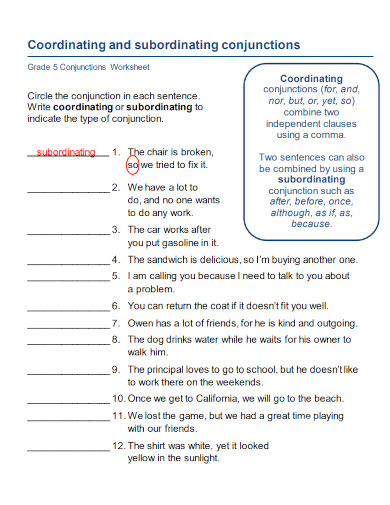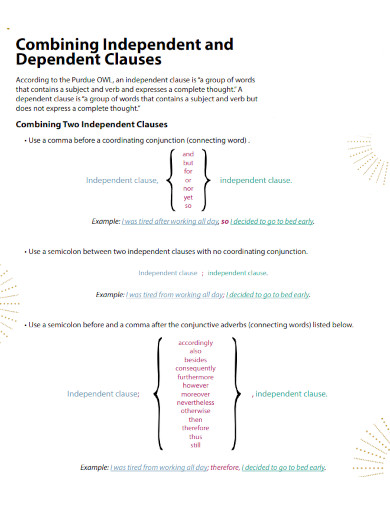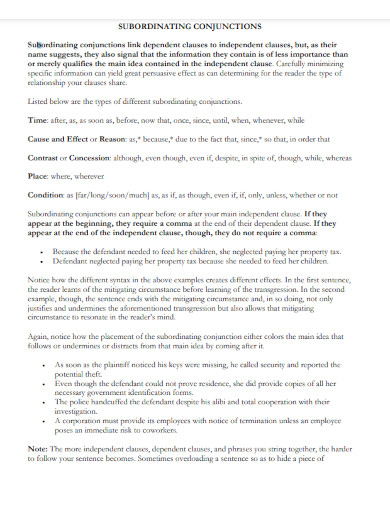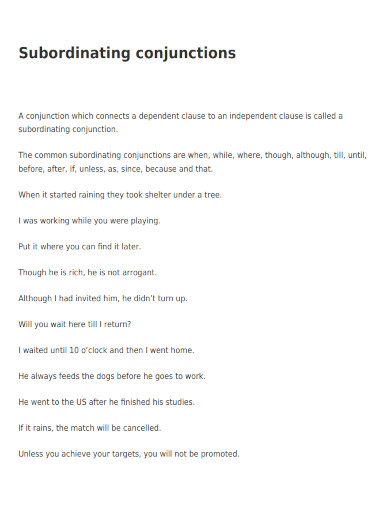50+ Subordinating Conjunction Examples
Subordinating conjunctions connect a dependent clause to an independent clause, indicating a relationship such as cause, time, condition, contrast, or purpose. They help create complex sentences by showing how the dependent clause relates to the main clause. Common subordinating conjunctions include “because,” “although,” “since,” “if,” “while,” and “after.” These conjunctions are essential for adding depth and detail to writing, enhancing clarity and meaning.
When trying to explain the cause-and-effect relationship between two phenomena, we use words like because, due to, and since. These words are examples or samples of subordinating conjunctions.
What Is a Subordinating Conjunction?
A subordinating conjunction connects a dependent clause to an independent clause, showing a relationship such as cause, time, condition, contrast, or purpose. Examples include “because,” “although,” “since,” “if,” “while,” and “after.” These conjunctions are essential for creating complex sentences and adding depth to writing.
Types of Subordinating Conjunctions
Subordinating conjunctions are words that connect a dependent clause to an independent clause, showing a relationship between the two. Here are the types of subordinating conjunctions categorized by the relationship they express, along with examples:
1. Cause and Effect
These conjunctions show that one event is the result of another.
- Examples: because, since, as, so that
- Example Sentences:
- “She stayed home because she was feeling ill.”
- “Since it was raining, we canceled the picnic.”
- “He works hard so that he can afford a nice vacation.”
2. Time
These conjunctions indicate when something happens.
- Examples: when, while, as soon as, before, after, until, since
- Example Sentences:
- “She called me when she arrived.”
- “While I was cooking, the phone rang.”
- “I will wait until you finish.”
3. Contrast
These conjunctions show a contrast or exception.
- Examples: although, though, even though, whereas, while
- Example Sentences:
- “Although it was late, he continued working.”
- “She loves him even though he is often late.”
- “Whereas she is very organized, her brother is quite messy.”
4. Condition
These conjunctions set up a condition for something to happen.
- Examples: if, unless, provided that, as long as
- Example Sentences:
- “If you study hard, you will pass the exam.”
- “We will go for a walk unless it rains.”
- “You can borrow my car as long as you drive carefully.”
5. Place
These conjunctions indicate where something happens.
- Examples: where, wherever
- Example Sentences:
- “She likes to sit where the sun is brightest.”
- “Wherever you go, I will follow.”
6. Purpose
These conjunctions show the purpose of an action.
- Examples: so that, in order that
- Example Sentences:
- “He saved money so that he could buy a house.”
- “She studied hard in order that she could get a scholarship.”
7. Manner
These conjunctions show the manner in which something is done.
- Examples: as, as if, as though
- Example Sentences:
- “She acted as if she knew everything.”
- “He talks as though he is an expert.”
8. Comparison
These conjunctions compare one thing to another.
- Examples: than, as…as
- Example Sentences:
- “She is taller than her brother.”
- “He is as intelligent as his sister.”
9. Reason
These conjunctions provide a reason for something.
- Examples: because, since, as
- Example Sentences:
- “He didn’t go to the party because he was tired.”
- “As it was getting late, we decided to leave.”
10. Concession
These conjunctions introduce a contrasting idea that still doesn’t negate the main clause.
- Examples: although, though, even though
- Example Sentences:
- “Even though it was raining, they went for a hike.”
- “Though he tried hard, he couldn’t solve the problem.”
Subordinating Conjunctions List
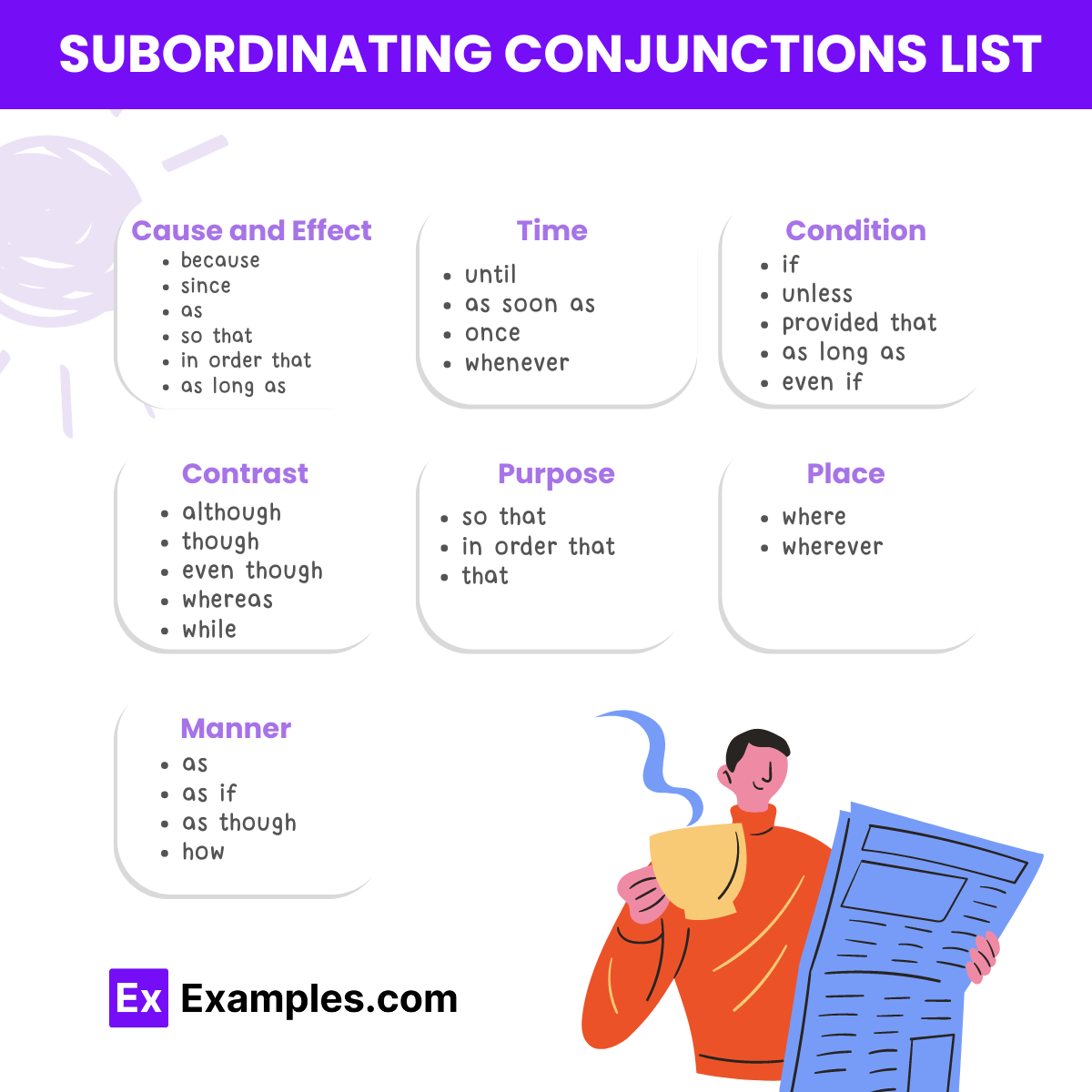
Here is a comprehensive list of common subordinating conjunctions, categorized by the type of relationship they indicate:
1. Cause and Effect:
- because
- since
- as
- so that
- in order that
- as long as
2. Time:
- when
- while
- after
- before
- until
- as soon as
- once
- whenever
3. Condition:
- if
- unless
- provided that
- as long as
- even if
- in case
- assuming that
4. Contrast:
- although
- though
- even though
- whereas
- while
5. Purpose:
- so that
- in order that
- that
6. Place:
- where
- wherever
7. Manner:
- as
- as if
- as though
- how
Subordinating Conjunctions Examples Sentences
1. Cause and Effect:
- “She stayed home because she was sick.”
- “I’ll call you since I arrive.”
- “He left early as he had an appointment.”
- “She practiced daily so that she could improve her skills.”
- “We whispered in order that we wouldn’t disturb anyone.”
2. Time:
- “Call me when you arrive.”
- “She read a book while waiting for the bus.”
- “We will start the meeting after everyone arrives.”
- “Finish your homework before you go out.”
- “We will wait here until the rain stops.”
- “I’ll call you as soon as I get home.”
- “They left once the show ended.”
- “You can come over whenever you want.”
3. Condition:
- “I’ll go if you come with me.”
- “You won’t pass the test unless you study.”
- “You can borrow my car provided that you fill up the tank.”
- “I’ll help you as long as you ask nicely.”
- “I’ll join you even if it rains.”
- “Take an umbrella in case it rains.”
- “We will go to the park assuming that the weather is nice.”
4. Contrast:
- “He went out although it was raining.”
- “She kept working though she was tired.”
- “They had fun even though it was a serious event.”
- “He prefers coffee, whereas she likes tea.”
- “She likes to read, while he prefers to watch TV.”
5. Purpose:
- “She studied hard so that she could pass the exam.”
- “He works extra hours in order that he can save more money.”
- “They left early that they might avoid traffic.”
6. Place:
- “You can sit where you like.”
- “She goes wherever her job takes her.”
7. Manner:
- “He did it as she had instructed.”
- “She behaves as if she owns the place.”
- “He talks as though he knows everything.”
- “Do it how you were taught.”
More Subordinating Conjunctions Templates & Examples:
1. Subordinating Conjunctions and Subordinate Clauses
2. List of Subordinating Conjunctions
3. Subordinating Conjunctions Template
4. Subordinate Conjunction Example
5. Student Subordinate Conjunction
6. Subordinating Conjunctions Worksheet
7. Subordinating Conjunctions Independent and Dependent Clauses
8. Example Subordinating Conjunctions
9. Sample Subordinating Conjunctions
Functions of Subordinating Conjunction
Subordinating conjunctions play a crucial role in sentence structure by linking dependent clauses to independent clauses. Here’s a breakdown of their functions:
1. Connecting Clauses:
Subordinating conjunctions connect a dependent clause to an independent clause, creating a complex sentence.
- Example: “She stayed home because she was sick.”
2. Indicating Relationships:
They indicate various relationships between the clauses, such as cause and effect, time, condition, contrast, purpose, place, and manner.
- Example: “I’ll go if you come with me.” (condition)
3. Adding Depth and Detail:
They add depth and detail to sentences by providing additional information about the main clause.
- Example: “He went out although it was raining.” (contrast)
4. Showing Cause and Effect:
They explain the reason or cause for something happening in the main clause.
- Example: “She studied hard so that she could pass the exam.”
5. Specifying Time:
They establish a timeline or sequence of events.
- Example: “Call me when you arrive.”
6. Setting Conditions:
They set conditions under which the action in the main clause occurs.
- Example: “You won’t pass the test unless you study.”
7. Contrasting Ideas:
They contrast one idea with another.
- Example: “He prefers coffee, whereas she likes tea.”
8. Expressing Purpose:
They express the purpose of the action in the main clause.
- Example: “She practices daily in order that she can improve.”
9. Indicating Place:
They indicate the place where the action of the main clause occurs.
- Example: “You can sit where you like.”
10. Describing Manner:
They describe the manner in which the action of the main clause is performed.
- Example: “He did it as she had instructed.”
Purpose of a Subordinating Conjunctions
Subordinating conjunctions are essential components of complex sentences, serving several critical functions in English grammar. They help connect dependent clauses to independent clauses, creating a relationship between the two parts of the sentence. Here are the primary purposes of subordinating conjunctions:
1. Establishing Relationships
Subordinating conjunctions show the relationship between the dependent clause and the independent clause. These relationships can include cause and effect, time, condition, contrast, and purpose.
Examples:
- Cause and Effect: “Because it was raining, we canceled the picnic.”
- Time: “When she arrived, the meeting had already started.”
- Condition: “If it snows, we will stay home.”
- Contrast: “Although he was tired, he finished his homework.”
- Purpose: “So that we can finish early, we will start the project today.”
2. Adding Complexity and Detail
By using subordinating conjunctions, writers can add complexity and detail to their sentences. This allows for more nuanced and specific information to be conveyed.
Example:
- “Even though the weather was bad, the team decided to play, which showed their dedication.”
3. Emphasizing Important Information
Subordinating conjunctions can help emphasize a particular part of a sentence. The independent clause often contains the main idea, while the dependent clause provides additional context.
Example:
- “She didn’t attend the party because she was ill.”
4. Indicating Time and Sequence
Subordinating conjunctions such as “after,” “before,” “when,” “until,” and “while” help indicate the timing and sequence of events.
Examples:
- “After we finish dinner, we will watch a movie.”
- “Before you leave, please check the weather.”
Subordinating Conjunctions Rules
Subordinating conjunctions are vital for connecting dependent clauses to independent clauses, creating complex sentences. Here are the essential rules for using subordinating conjunctions:
1. Placement of Subordinating Conjunctions
Subordinating conjunctions can appear at the beginning or in the middle of a sentence. When placed at the beginning, the dependent clause precedes the independent clause.
Examples:
- Beginning: “Because it was raining, we stayed indoors.”
- Middle: “We stayed indoors because it was raining.”
2. Punctuation Rules
- Dependent Clause First: When the dependent clause comes first, use a comma to separate it from the independent clause.
- Example: “Although it was late, he continued working.”
- Independent Clause First: When the independent clause comes first, do not use a comma.
- Example: “He continued working although it was late.”
3. Creating Complex Sentences
Subordinating conjunctions are used to create complex sentences, which include an independent clause and a dependent clause. The dependent clause cannot stand alone and needs the independent clause to form a complete thought.
Example:
- “When she called, he answered immediately.”
4. Expressing Different Relationships
Use subordinating conjunctions to express various relationships between clauses, such as time, cause and effect, contrast, condition, and purpose.
- Time: after, before, when, while, as soon as
- Example: “After she finished her homework, she watched TV.”
- Cause and Effect: because, since, as
- Example: “She stayed home because she was sick.”
- Contrast: although, though, even though, whereas
- Example: “Although it was raining, they went hiking.”
- Condition: if, unless, provided that
- Example: “If it rains, we will cancel the picnic.”
- Purpose: so that, in order that
- Example: “He studied hard so that he could pass the exam.”
5. Avoiding Sentence Fragments
Ensure that the dependent clause is always connected to an independent clause to avoid sentence fragments. A dependent clause cannot stand alone as a complete sentence.
Incorrect: “Because she was tired.” Correct: “She went to bed early because she was tired.”
6. Consistent Tense Usage
Maintain consistent tense usage between the dependent and independent clauses to ensure clarity and coherence.
Example:
- “When he arrived, she was cooking dinner.”
7. Avoiding Redundancy
Avoid using subordinating conjunctions unnecessarily or redundantly within the same sentence.
Incorrect: “Although he was tired, but he finished the work.” Correct: “Although he was tired, he finished the work.”
Subordinating Conjunctions vs. Coordinating Conjunctions
| Feature | Subordinating Conjunctions | Coordinating Conjunctions |
|---|---|---|
| Function | Connects a dependent clause to an independent clause | Connects words, phrases, or independent clauses |
| Examples | because, although, if, when, since, after, while | for, and, nor, but, or, yet, so |
| Clause Dependency | Creates a dependent clause | Connects independent clauses or equal elements |
| Punctuation Rules | Comma used if dependent clause comes first | Comma before the conjunction in a compound sentence |
| Sentence Example (Dependent Clause First) | “Because it was raining, we stayed inside.” | N/A (No dependent clause) |
| Sentence Example (Independent Clause First) | “We stayed inside because it was raining.” | “She wanted to go, but she was too tired.” |
| Position in Sentence | Can appear at the beginning or in the middle | Typically appears in the middle |
| Types of Relationships | Time, cause/effect, condition, contrast, purpose | Addition, contrast, choice, result, reason |
| Common Conjunctions | when, because, if, although, since, after, while | for, and, nor, but, or, yet, so |
How to Use Subordinating Conjunctions
The subordinating conjunction allows the writer to easily create a complex structured sentence with a dependent and an independent clause. A well-written subordinating clause will introduce or fix the flow of the complex statement allowing the reader to have a more in-depth understanding of the statement
1.) If Needed, Open or Obtain a List of Subordinating Conjunctions
If you have not memorized all the possible subordinating conjunctions, then you will need to begin by opening or obtaining a list of subordinating conjunctions. This will help with the construction of the overall statement.
2.) Determine the Connection Between the Dependent and the Independent Clause
If you want to use subordinate conjunctions, you must first prepare the dependent and the independent clause. The dependent clause must be related to the independent clause before both clauses will be attached. This is because we want the tone, theme, and context of the sentence to align with each other. You can also opt to use an outline that will detail all the elements of the complex sentence.
3.) Choose the Location of the Dependent Clause in the Statement
Select the location of the dependent clause in the overall sentence. The dependent clause can be located before or after the independent clause. Which is accompanied by the subordinating conjunction.
4.) Insert the Dependent Clause with the Subordinating Conjunction
After determining the location of the dependent clause in the sentence or statement, you will now insert the dependent clause to establish the relationship between the two. Often the writer uses the subordinating conjunction at the beginning of the dependent clause.
What are subordinating conjunctions?
Subordinating conjunctions connect a dependent clause to an independent clause, indicating relationships like time, cause and effect, condition, contrast, and purpose.
Can subordinating conjunctions start a sentence?
Yes, subordinating conjunctions can start a sentence, placing the dependent clause first, followed by a comma and the independent clause.
How do subordinating conjunctions differ from coordinating conjunctions?
Subordinating conjunctions connect dependent and independent clauses, while coordinating conjunctions join elements of equal importance, like two independent clauses.
What is an example of a sentence with a subordinating conjunction?
“Although it was raining, they went for a walk.” Here, “although” is the subordinating conjunction.
Is a comma needed with subordinating conjunctions?
Use a comma when the dependent clause comes first. No comma is needed if the independent clause comes first.
Can a subordinating conjunction be in the middle of a sentence?
Yes, subordinating conjunctions often appear in the middle, connecting a dependent clause to an independent clause.
Do subordinating conjunctions affect verb tense?
No, subordinating conjunctions do not affect verb tense but maintain consistent tense between the clauses for clarity.
What are common subordinating conjunctions?
Common subordinating conjunctions include because, although, if, when, since, after, while, before, until, and unless.
Can you use multiple subordinating conjunctions in one sentence?
Yes, but ensure clarity and avoid overcomplicating the sentence. Each conjunction should introduce a new dependent clause.
How do subordinating conjunctions enhance writing?
Subordinating conjunctions add complexity, detail, and clarity to writing, helping to show relationships between ideas and enhancing sentence structure.



